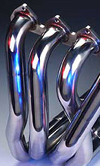Welding Inconel
 As long as there is the pursuit for extra power there will always have to be a commitment to using more advanced and exotic materials. Exhaust design is no exception, and many exhaust systems - both classic and contemporary - provide us not only with engineering artwork but a technical challenge.
As long as there is the pursuit for extra power there will always have to be a commitment to using more advanced and exotic materials. Exhaust design is no exception, and many exhaust systems - both classic and contemporary - provide us not only with engineering artwork but a technical challenge.
One criterion expected of performance exhausts is their need to work at sustained elevated working temperatures, which has necessitated the use of more sophisticated and complex materials. Increasing temperature exposure has also called for greater resistance to corrosion and creep. As mentioned in previous RET-Monitor articles, this has led to the use of Inconel.
Inconel is a trade name given to a group of high-temperature nickel chromium 'super-alloys' that exhibit exceptional high-temperature corrosion resistance, resistance to creep, fatigue and, in the case of Inconel 625, excellent weldability. Inconel has proved itself in the nuclear and defence sectors and made its way into performance marine and automotive exhaust systems because of its exemplary mechanical properties.
According to Joe Ellis, managing director of BTB Exhausts in Daventry, England, it seems that there are few problems with using Inconel compared to stainless and titanium systems. Although Inconel 625, for example, shows good weldability and needs no post- or pre-heat treatment to maintain mechanical properties during the welding process, the fabrication of Inconel requires the use of pre-annealed material.
Because of the atomic structure of these high-nickel alloys, they are subject to high rates of strain hardening when cold-worked. Using pre-annealed material increases ductility and allows the material to be bent to the required radius without cold-working to failure. The use of sheet material to form tubes also allows the seam to be concealed in a position that satisfies aesthetics, as well as improving strength by positioning these seams correctly.
Ellis says, "Many people think Inconel will be lighter, but its density is higher than that of stainless or titanium." Therefore, to maintain or reduce weight over a titanium or stainless steel equivalent, the Inconel system will necessitate a reduction in wall section thickness. Although this reduction can have benefits such as aiding heat transfer, it is rare to see these super-alloys in applications where impact resistance is a prerequisite.
Inconel 625 can be welded using a number of techniques depending on the application and required properties. TIG welding - or Tungsten Inert Gas welding, so called as it uses a thoriated pure tungsten electrode - is favoured in exhaust fabrication due to the thin-wall section used in construction. In fabrication, cleanliness and fit is key, in order to minimise distortion and maintain integrity it is important to maintain an excellent tube-to-tube fit.
Eliminating distortion is not always possible, but this can be accounted for within the jig-and-fixture design. It is possible to omit a root gap because of the thin-gauge section used. The use of a pure argon back-purge helps not only to maintain the internal cross-sectional area and finish, this process also protects the weld root from reaction with oxygen during the welding and cooling process. Removing this internal argon gas protection can lead to porosity and oxidization.
Welding research by major organisations is ongoing; there is still the weldability of a number of super-alloys that require investigation, which will enable us to see ever more expensive and exotic materials being used in exhaust fabrication. With a similar commitment to filler and welding development, could exhaust metallurgy rival that of the aerospace and nuclear fields?
Fig. 1 - A BTB header fabricated using an Argon back-purge
Written by Chris Thwaites